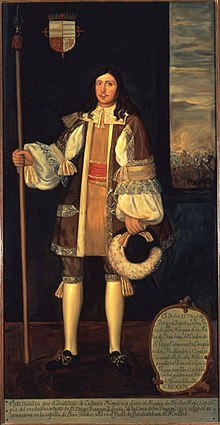Diego de Vargas
| Diego De Vargas Zapata y Luján Ponce De León y Contreras | |
|---|---|

Oil on canvas portrait of Diego de Vargas by Julio Barrera, date unknown, from the collection of the Palace of the Governors
|
|
| 30th and 32nd Spanish Governor of New Mexico | |
|
In office 1691 – 1697 (as effective) (titular 1688–91) |
|
| Preceded by | Domingo Jironza Petriz de Cruzate |
| Succeeded by | Pedro Rodríguez Cubero |
|
In office 1697–1703 |
|
| Preceded by | Pedro Rodríguez Cubero |
| Succeeded by | Juan Páez Hurtado |
| Personal details | |
| Born | 1643 Madrid, Spain |
| Died | 1704 Unknown |
| Profession | Political and military |
| Religion | Christian |
| Signature |  |
Diego de Vargas Zapata y Luján Ponce de León y Contreras (1643 in Spain – 1704), commonly known as Don Diego de Vargas, was a Spanish Governor of the New Spain territory of Santa Fe de Nuevo México, to the US states of New Mexico and Arizona, titular 1690–1695, effective 1692–1696 and 1703–1704. He is most famous for leading the reconquest of the territory in 1692 following the Pueblo Revolt of 1680. This reconquest is commemorated annually during the Fiestas de Santa Fe in the city of Santa Fe.
On August 10, 1680, Pueblo people from various pueblos in northern New Mexico staged an uprising against Spanish colonists. They laid siege to the city of Santa Fe, forcing the Spanish to retreat on August 20. The colonists fled south to El Paso del Norte (now Ciudad Juárez, Mexico), where they remained in exile for the next 12 years.
In 1688, Capitan General y Governador Don Diego de Vargas was appointed Governor of New Mexico, though he did not arrive to assume his duties until (February 22), 1691. He was assigned with the task of reconquering and pacifying the New Mexico territory for Spain. In July 1692, de Vargas and a small contingent of soldiers returned to Santa Fe. They surrounded the city and called on the Pueblo people to surrender, promising clemency if they would swear allegiance to the King of Spain and return to the Christian faith. After meeting with de Vargas, the Pueblo leaders agreed to peace, and on September 12, 1692 de Vargas proclaimed a formal act of repossession.
De Vargas’ repossession of New Mexico is often called a bloodless reconquest, since the territory was initially retaken without any use of force. Later, when de Vargas returned to Mexico in early 1693 to retrieve a group of settlers, they had to fight their way into Santa Fe. Warriors from four of the pueblos sided with the colonists, but most opposed them. When the capital had been taken, Don Diego ordered some 70 of the Pueblo men killed. Women and children were distributed as servants to the colonists. Similar bloody fighting occurred at many of the other pueblos before the governor felt that the native people had truly submitted to his and the king's authority. The end of widespread hostilities did not mean an end to Pueblo resentment over continued heavy-handed treatment by the colonists. The plundering of Pueblo stocks of corn and other supplies, to sustain the struggling colony, was a periodic occurrence that inflamed animosity. By the end of the century the Spanish colonization was essentially solidified.
...
Wikipedia
